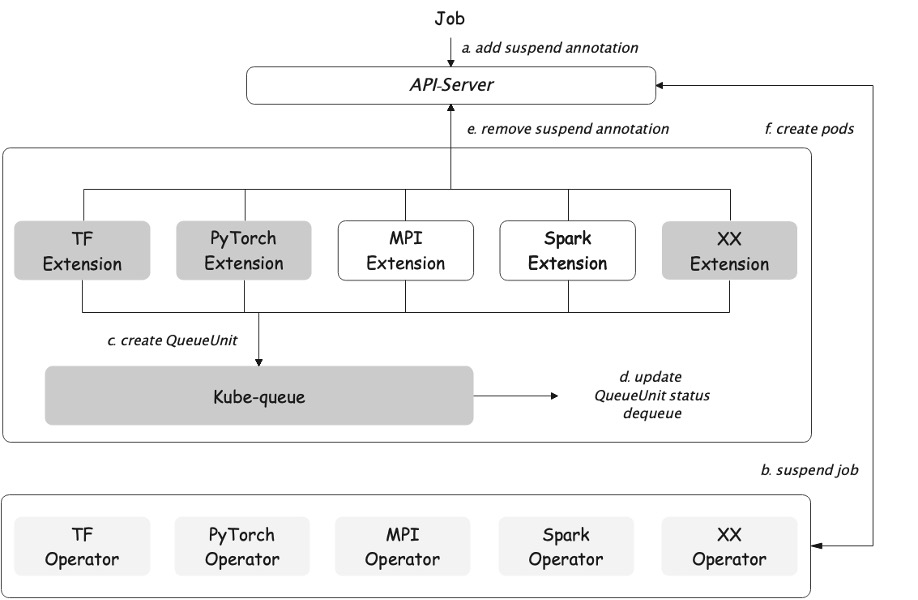kube-queue is designed to manage AI/ML and batch workloads in Kubernetes. It allows system admins to customize job queue management for queues to provide flexibility and fairness between different queues. Combined with a quota system (similar to Kubernetes resource quota), kube-queue automates and optimizes workload and resource quota mangement to maximize cluster resource utilization.
- Job queue based on workload priority and creation time and quota
- Support dynamic adjustment of job priority in queue
- Provide faireness between queues
- Clone this repo to your machine
$ git clone https://github.com/kube-queue/kube-queue.git- Change to kube-queue directory:
$ cd kube-queue- Deploy kube-queue with Helm
$ helm install kube-queue -n kube-system ./charts/v0.0.1
NAME: kube-queue
LAST DEPLOYED: Mon Sep 13 10:15:34 2021
NAMESPACE: kube-system
STATUS: deployed
REVISION: 1
TEST SUITE: None- Check running status of kube-queue
$ helm get manifest kube-queue -n kube-system | kubectl get -n kube-queue -f -
NAME STATUS AGE
namespace/kube-queue Active 2m17s
NAME SECRETS AGE
serviceaccount/kube-queue 1 2m16s
NAME CREATED AT
customresourcedefinition.apiextensions.k8s.io/queueunits.scheduling.x-k8s.io 2021-09-13T02:15:36Z
NAME CREATED AT
clusterrole.rbac.authorization.k8s.io/kube-queue 2021-09-13T02:15:36Z
NAME ROLE AGE
clusterrolebinding.rbac.authorization.k8s.io/kube-queue-clusterrolebinding ClusterRole/kube-queue 2m16s
NAME READY UP-TO-DATE AVAILABLE AGE
deployment.apps/kube-queue-controller 1/1 1 1 2m16s
deployment.apps/tf-operator-extension 1/1 1 1 2m17s
deployment.apps/pytorch-operator-extesion 1/1 1 1 2m17s- Uninstall kube-queue with Helm
$ helm uninstall kube-queue -n kube-systemWe will submit two tensorflow (tf) jobs to the cluster at the same time, but the current cluster can only meet the resource requests of one job so one job is running and the other job is queued by kube-queue, and the pods of the queued job are not created.
1. Deploy tf-operator that can support queue ( Ensure that no other tf-operator is deployed in the cluster)
$ kubectl apply -f examples/tf-operator/
customresourcedefinition.apiextensions.k8s.io/tfjobs.kubeflow.org created
serviceaccount/tf-job-operator created
clusterrole.rbac.authorization.k8s.io/tf-job-dashboard created
clusterrole.rbac.authorization.k8s.io/tf-job-operator created
clusterrolebinding.rbac.authorization.k8s.io/tf-job-operator created
deployment.apps/tf-job-operator created$ kubectl get -f examples/tf-operator/
NAME CREATED AT
customresourcedefinition.apiextensions.k8s.io/tfjobs.kubeflow.org 2021-09-13T06:46:39Z
NAME SECRETS AGE
serviceaccount/tf-job-operator 1 9s
NAME CREATED AT
clusterrole.rbac.authorization.k8s.io/tf-job-dashboard 2021-09-13T06:46:39Z
clusterrole.rbac.authorization.k8s.io/tf-job-operator 2021-09-13T06:46:39Z
NAME ROLE AGE
clusterrolebinding.rbac.authorization.k8s.io/tf-job-operator ClusterRole/tf-job-operator 9s
NAME READY UP-TO-DATE AVAILABLE AGE
deployment.apps/tf-job-operator 1/1 1 1 8s$ kubectl create -f examples/tfjob/resource_quota.yaml
resourcequota/default created
$ kubectl get resourcequota default -o wide
NAME AGE REQUEST LIMIT
default 76s cpu: 0/4, memory: 0/4Gi$ kubectl create -f examples/tfjob/job1.yaml;kubectl create -f examples/tfjob/job2.yaml
tfjob.kubeflow.org/job1 created
tfjob.kubeflow.org/job2 created5.1 At the beginning, only one job creates the pod and runs successfully.
$ kubectl get tfjob
NAME STATE AGE
job1 Running 5s
job2 Queuing 5s
$ kubectl get pods
NAME READY STATUS RESTARTS AGE
job1-ps-0 1/1 Running 0 8s
job1-worker-0 1/1 Running 0 8s
job1-worker-1 1/1 Running 0 8s5.2 When the state of job1 is Succeeded. Job2 will continue to run.
$ kubectl get tfjob
NAME STATE AGE
job1 Succeeded 38s
job2 Running 38s
$ kubectl get pods
NAME READY STATUS RESTARTS AGE
job1-worker-0 0/1 Completed 0 54s
job1-worker-1 0/1 Completed 0 54s
job2-ps-0 1/1 Running 0 22s
job2-worker-0 1/1 Running 0 22s
job2-worker-1 1/1 Running 0 21s5.3 Finally, the state of the two jobs are Succeeded.
$ kubectl get tfjob
NAME STATE AGE
job1 Succeeded 71s
job2 Succeeded 71s
$ kubectl get pods
NAME READY STATUS RESTARTS AGE
job1-worker-0 0/1 Completed 0 5m
job1-worker-1 0/1 Completed 0 5m
job2-ps-0 0/1 Completed 0 4m28s
job2-worker-0 0/1 Completed 0 4m28s
